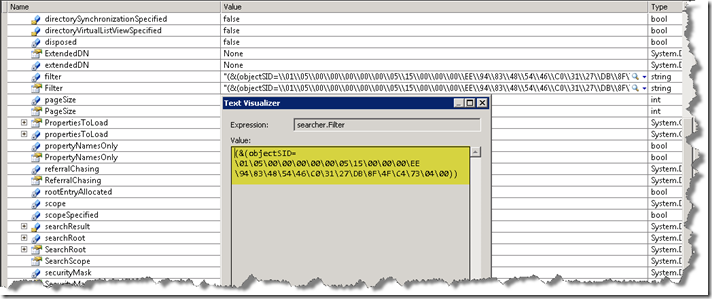关于斜杠(slash)和反斜杠(back slash)的小知识点
这两个总容易记混, 其实英文版的更好记一些, 往前倒的叫斜杠, 往后倒的叫反斜杠. 呵呵.
在WinDBG中, 捞到一个DirectorySearcher的Filter成员的值如下:
0:014> !do rdx
Unable to enumerate managed locals, HRESULT 0x80004001
Unable to enumerate managed locals, HRESULT 0x80004001
Name: System.String
MethodTable: 000007fef91a7c18
EEClass: 000007fef8dae530
Size: 414(0x19e) bytes
GC Generation: 0
(C:\Windows\assembly\GAC_64\mscorlib\2.0.0.0__b77a5c561934e089\mscorlib.dll)
String: (&(objectSID=\01\05\00\00\00\00\00\05\15\00\00\00\EE\94\83\48\54\46\C0\31\27\DB\8F\4F\C4\73\04\00))
Fields:
MT Field Offset Type VT Attr Value Name
000007fef91aee88 4000096 8 System.Int32 1 instance 195 m_arrayLength
000007fef91aee88 4000097 c System.Int32 1 instance 99 m_stringLength
000007fef91a9660 4000098 10 System.Char 1 instance 28 m_firstChar
000007fef91a7c18 4000099 20 System.String 0 shared static Empty
>> Domain:Value 0000000000131320:00000000ff490370 0000000002709600:00000000ff490370 <<
000007fef91a9510 400009a 28 System.Char[] 0 shared static WhitespaceChars
>> Domain:Value 0000000000131320:00000000ff490ac0 0000000002709600:000000019f4955f0 <<
自己写了段C#代码使用这个值向AD查询用户的时候, 发现这里的斜杠再过编译时遇到了点问题.
尝试过在字符串前面添加一个@符号, 可是没有用, 还是过不了编译.
把所有的反斜杠都变成双反斜杠, 可以发现, 这个值是正确的了. 如下:
验证
这里用到了C#中的转义字符的一些知识
C# defines the following character escape sequences:
\'- single quote, needed for character literals\"- double quote, needed for string literals\\- backslash\0- Unicode character 0\a- Alert (character 7)\b- Backspace (character 8)\f- Form feed (character 12)\n- New line (character 10)\r- Carriage return (character 13)\t- Horizontal tab (character 9)\v- Vertical quote (character 11)\uxxxx- Unicode escape sequence for character with hex value xxxx\xn[n][n][n]- Unicode escape sequence for character with hex value nnnn (variable length version of \uxxxx)\Uxxxxxxxx- Unicode escape sequence for character with hex value xxxxxxxx (for generating surrogates)
Of these, \a, \f, \v, \x and \U are rarely used in my experience.
[Author: Jon Skeet]
关于@符号
这里以@为前缀的字符串叫做verbatim string. 举例:
这个路径的格式被认为是丑陋且尴尬的
string path = "C:\\Program Files\\Microsoft Visual Studio 10.0\\";
一个更方便的版本是使用verbatim string
string path = @"C:\Program Files\Microsoft Visual Studio 10.0\";
Verbatim string(@"...")将其内容认为为纯内容, 不需对任何字符进行转义. 然而, 有一个字符即使在verbatim string也须进行转义, 那就是内嵌的双引号("), 它必须被转义为(""). 举例:
string xml = @"<?xml version=""1.0""?> <Data> ... <Data>";
Reference
==================
What character escape sequences are available?
Escape Sequences
http://msdn.microsoft.com/en-us/library/h21280bw.aspx
Escaping in C#: characters, strings, string formats, keywords, identifiers
http://www.codeproject.com/Articles/371232/Escaping-in-Csharp-characters-strings-string-forma




 浙公网安备 33010602011771号
浙公网安备 33010602011771号